You’ll choose Unity’s SDK for immersive development because it delivers unparalleled cross-platform deployment across 20+ platforms from a single codebase, cutting development time and costs remarkably. Unity’s Universal Render Pipeline maintains critical 90Hz frame rates while the XR Interaction Toolkit provides robust haptic feedback and gesture recognition for intuitive user experiences. With proven success stories like Cincinnati Children’s Hospital’s VR surgical planning platform, Unity’s extensive ecosystem transforms complex VR visions into industry-leading applications that’ll reshape your development approach.
Understanding Unity’s Position in the VR Development Landscape
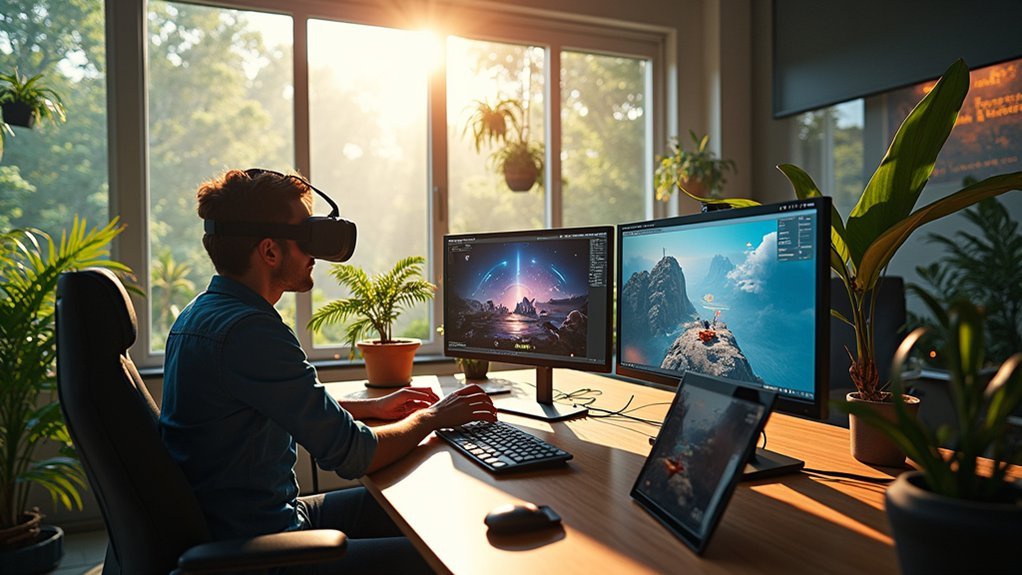
When you’re exploring VR development platforms, Unity stands out as the industry leader, powering immersive experiences across gaming, architecture, automotive, education, and enterprise sectors.
You’ll find Unity’s dominance stems from its versatility and extensive toolkit designed specifically for VR creation.
Unity’s platform supports diverse industries because it adapts to different requirements seamlessly. Whether you’re developing training simulations for automotive companies, educational experiences for schools, or architectural walkthroughs for clients, Unity provides the foundation you need.
The platform’s widespread adoption means you’re joining a proven ecosystem with established workflows and industry standards.
You’ll benefit from Unity’s continuous innovation in VR technology, ensuring your projects remain cutting-edge. This market leadership position translates into better support, more resources, and compatibility with the latest VR hardware and software developments.
Cross-Platform VR Deployment Capabilities
You’ll find Unity’s SDK excels at deploying your VR applications across more than 20 platforms, from mobile devices to high-end VR headsets like Meta Quest and PlayStation VR.
Your development workflow becomes dramatically more efficient since you’re working with a single codebase that adapts to multiple operating systems without requiring separate builds.
Unity’s rendering engine automatically optimizes performance for each target platform, ensuring your immersive experiences maintain visual quality and smooth framerates regardless of hardware specifications.
Multi-Platform Device Support
Unity’s SDK empowers you to deploy immersive applications across more than 20 platforms with a single codebase, dramatically streamlining your development workflow. You’ll reduce development time and costs while targeting Windows, macOS, iOS, and Android simultaneously. These multi-platform capabilities guarantee consistent user experiences across various devices, enhancing accessibility and engagement.
| Platform Category | Supported Devices |
|---|---|
| Mobile | iOS, Android smartphones/tablets |
| Desktop | Windows, macOS, Linux |
| AR/VR | Meta Quest, HoloLens, PICO |
| Gaming Consoles | PlayStation, Xbox, Nintendo Switch |
Unity’s XR Interaction Toolkit simplifies cross-platform development through its component-based system, making it easier to build immersive experiences that function seamlessly across different hardware. Regular updates assure ongoing support for emerging platforms, keeping you at the forefront of immersive development trends.
Seamless Development Workflow
Because modern VR development demands efficiency across multiple platforms, Unity’s streamlined workflow transforms how you build and deploy immersive experiences.
You’ll leverage a single codebase to target over 20 platforms simultaneously, eliminating the costly process of creating separate versions for different operating systems. The development platform accelerates your workflow through Unity’s extensive asset store, providing ready-to-use tools for faster prototyping and iteration.
Unity’s Universal Render Pipeline optimizes graphics performance for each target platform automatically, ensuring consistent quality across devices.
When you’re creating immersive training applications, the built-in XR Interaction Toolkit simplifies VR integration, making platform adaptation straightforward.
You’ll reduce development time considerably while maintaining high-quality standards, allowing you to focus on creating compelling content rather than managing technical complexities across multiple deployment targets.
Performance Optimization Across Platforms
Building for multiple platforms requires more than just deployment flexibility—it demands enhanced performance that maintains quality across diverse hardware configurations.
Unity’s performance optimization features guarantee your VR applications run smoothly across all target platforms without compromising user experience.
The Universal Render Pipeline delivers consistent 90Hz frame rates essential for preventing motion sickness, while automatically adjusting graphics quality based on device capabilities.
You’ll leverage Unity’s Data-Oriented Technology Stack to maximize multicore processor efficiency, enabling complex VR simulations that maintain superior performance standards.
The XR Interaction Toolkit’s component-based system streamlines UI and 3D interactions across development platforms, reducing processing overhead.
This thorough optimization approach means you’re not sacrificing performance for cross-platform compatibility—you’re enhancing it through intelligent resource management and platform-specific adjustments.
Universal Render Pipeline for Optimized VR Graphics
You’ll find Unity’s Universal Render Pipeline transforms your VR graphics optimization by delivering enhanced rendering performance that maintains the vital 90hz frame rates needed for immersive experiences.
The lightweight architecture guarantees your applications run smoothly across diverse VR platforms without sacrificing visual quality.
URP’s modern GPU utilization gives you sophisticated lighting and shading capabilities while maintaining the cross-platform compatibility indispensable for reaching users on different VR devices.
Enhanced Rendering Performance
When developing VR applications, you’ll find that Unity’s Universal Render Pipeline (URP) delivers the optimized rendering performance vital for immersive experiences.
URP’s lightweight architecture guarantees you’ll achieve the smooth 90Hz frame rates essential for preventing motion sickness and maintaining user comfort. The pipeline’s data-oriented technology maximizes multicore processor efficiency, giving you the enhanced rendering performance needed for demanding VR environments.
Key benefits of URP’s enhanced rendering performance include:
- Consistent 90Hz frame rates that reduce motion sickness and improve comfort
- Advanced dynamic lighting systems that create realistic, immersive environments
- Optimized multicore processor utilization for maximum performance efficiency
- Cross-platform compatibility guaranteeing consistent experiences across all VR devices
- Customizable post-processing effects that enhance visual quality without compromising speed
Cross-Platform VR Compatibility
Unity’s Universal Render Pipeline guarantees your VR applications deliver consistent, high-quality graphics across diverse platforms, from Meta Quest headsets to PlayStation VR systems.
You’ll achieve seamless cross-platform compatibility without compromising visual fidelity or performance optimization.
URP’s customizable rendering settings let you tailor graphics specifically for each VR device’s hardware capabilities. You can maintain that essential 90Hz frame rate across different platforms, ensuring users experience smooth, comfortable gameplay regardless of their chosen headset.
The pipeline’s dynamic lighting and shadows create immersive environments that translate beautifully across various VR ecosystems.
When you integrate URP with Unity’s XR Interaction Toolkit, you’re streamlining your cross-platform development workflow.
This combination eliminates the need to rebuild applications from scratch for different VR platforms, saving development time while ensuring consistent user experiences.
XR Interaction Toolkit for Seamless VR Experiences
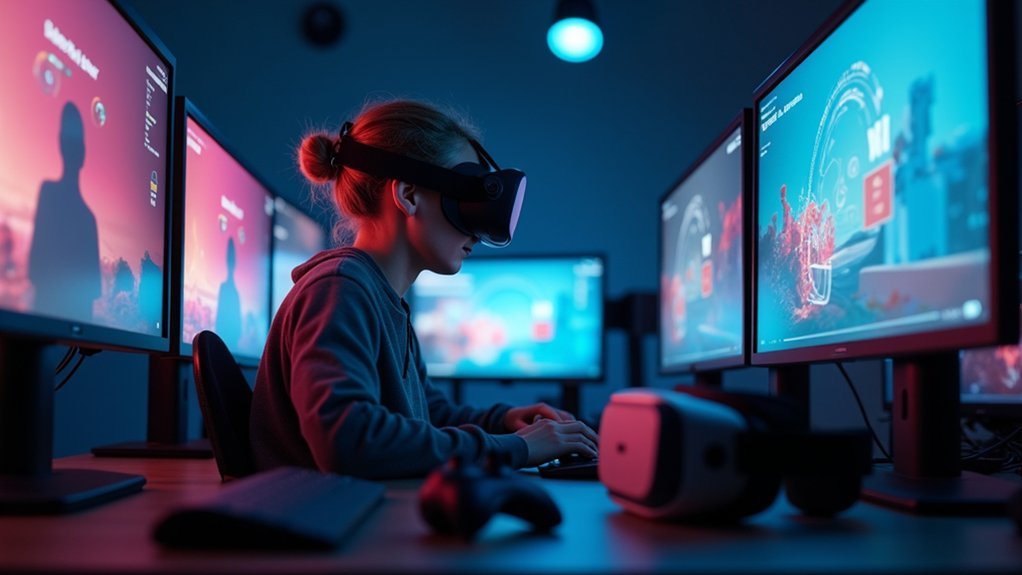
As immersive technology demands increasingly sophisticated interactions, the XR Interaction Toolkit emerges as Unity’s all-encompassing solution for streamlining VR and AR development.
You’ll leverage this component-based system to create interactive interfaces and 3D interactions with minimal coding effort, dramatically accelerating your development timeline.
The toolkit revolutionizes how you build immersive experiences through:
The toolkit revolutionizes immersive experience development through predefined components, cross-platform compatibility, haptic feedback, and advanced gesture recognition capabilities.
- Predefined components for grabbing, throwing, and UI manipulation that eliminate repetitive coding
- Cross-platform compatibility enabling seamless deployment across desktop and VR platforms
- Robust haptic feedback integration that enhances tactile user engagement
- Advanced gesture recognition capabilities for intuitive user interactions
- Continuous updates delivering cutting-edge XR technology advancements
You’ll expand your audience reach while maintaining development efficiency, as the XR Interaction Toolkit handles complex interaction frameworks automatically, letting you focus on creating compelling content.
Visual Scripting Tools for Enhanced Development Workflow
Since complex immersive applications often require diverse skill sets from multiple team members, Unity’s Visual Scripting transforms development workflows by democratizing the creation process through intuitive drag-and-drop mechanics.
You’ll enable artists and designers to prototype gameplay mechanics without extensive programming knowledge, fostering collaboration across your entire team.
This visual scripting system integrates seamlessly with Unity’s existing components, allowing smooth shifts between visual and traditional coding approaches.
You can debug and test in real-time, identifying issues early in development. The tool works efficiently with Unity’s Data-Oriented Technology Stack, optimizing performance on multicore processors for demanding immersive experiences.
Performance Optimization Features for VR Applications
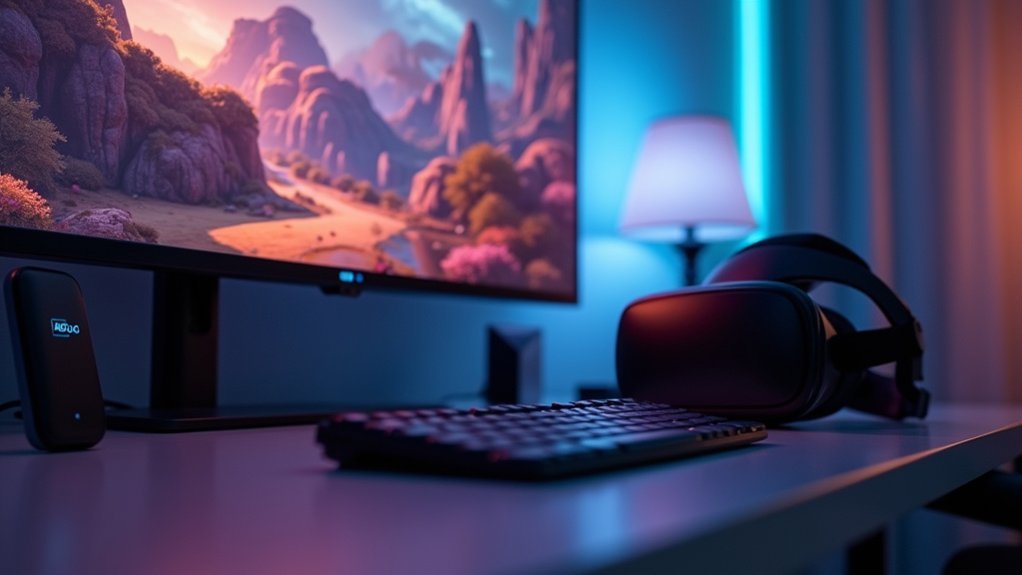
When you’re building VR applications, Unity’s performance optimization features become essential for delivering smooth, immersive experiences that won’t cause motion sickness or user fatigue.
You’ll find that the platform’s advanced rendering pipeline optimization and sophisticated memory management techniques work together to maintain the critical 90Hz frame rate required for comfortable VR usage.
These optimization tools help you identify and eliminate performance bottlenecks before they impact your users’ experience.
Advanced Rendering Pipeline Optimization
While developing VR applications demands exceptional performance standards, Unity’s advanced rendering pipeline enhancement features guarantee you’ll meet the critical 90Hz refresh rate requirements without compromising visual quality.
Unity’s Universal Render Pipeline (URP) delivers high-fidelity graphics with enhanced performance enhancement, ensuring smooth rendering across all VR platforms.
Unity’s rendering pipeline includes these enhancement features:
- Data-Oriented Technology Stack (DOTS) efficiently utilizes multicore processors for enhanced frame rates
- Dynamic lighting and shadowing systems maintain visual quality while preserving performance standards
- Real-time performance analysis tools identify bottlenecks and enable quick implementation of effective solutions
- Lightweight rendering techniques minimize resource consumption for maximum battery life
- Advanced post-processing effects enhance visual appeal without sacrificing responsiveness
These features work together to deliver exceptional VR experiences.
Memory Management Techniques
Beyond optimizing rendering processes, Unity’s memory management techniques form the backbone of high-performance VR applications that maintain consistent frame rates throughout extended user sessions.
You’ll leverage Unity’s Data-Oriented Technology Stack (DOTS) to maximize multicore processor performance while reducing memory overhead. Object pooling becomes essential for your VR projects, as it eliminates continuous object creation and destruction during runtime.
Unity’s Addressable Asset System lets you dynamically load and unload assets, guaranteeing only necessary resources occupy memory. The Universal Render Pipeline contributes optimized shaders that reduce memory footprint while boosting frame rates.
You’ll monitor real-time memory usage through Unity’s Memory Profiler, enabling targeted optimizations. These memory management strategies collectively guarantee your VR applications deliver smooth, uninterrupted experiences that keep users immersed without performance degradation.
Asset Store Resources for VR Development
Unity’s Asset Store houses thousands of specialized resources that’ll accelerate your VR development workflow.
You’ll discover an extensive collection of 3D models, animations, sound effects, and scripts specifically crafted for immersive experiences. These pre-made Unity Asset options dramatically enhance your project quality while reducing development time.
Community-created resources provide diverse solutions for every VR development challenge you’ll encounter. You can access professional-grade assets at cost-effective prices, eliminating the need for expensive custom content creation.
The store’s frequent updates guarantee you’re always working with cutting-edge tools and innovative solutions.
Key Asset Store benefits for VR developers:
- High-quality 3D models and animations ready for immediate implementation
- Specialized VR scripts and tools for common development challenges
- Sound effects and audio assets optimized for immersive experiences
- Cost-effective alternatives to custom asset development
- Regular community contributions maintaining fresh, innovative resources
Community Support and Developer Ecosystem
The vibrant community surrounding Unity amplifies these Asset Store benefits through extensive knowledge sharing and collaborative support.
You’ll find an active developer ecosystem that facilitates troubleshooting and accelerates your learning curve through forums, tutorials, and detailed documentation. Unity’s community support extends across Facebook and Reddit groups where you can discuss best practices, share resources, and collaborate on projects.
Unity offers free educational pathways like Unity Essentials and Junior Programmer courses, helping you enhance your proficiency regardless of skill level.
Through user groups, you’ll discover networking opportunities that enable developers to create innovative solutions together. This collaborative environment, combined with community-created assets, reduces development time while improving project quality through shared expertise and resources.
Integration With Industry-Standard 3D Software
When you’re working with professional 3D content creation, Unity’s seamless integration with industry-standard software like Blender, Maya, and 3ds Max eliminates the typical workflow bottlenecks that can slow down development.
You’ll import high-quality assets efficiently while maintaining visual fidelity through Unity’s Universal Render Pipeline.
The platform’s integration capabilities include:
- Direct conversion of engineering CAD and BIM data into usable 3D assets
- C# scripting and open APIs for customizing training applications alongside existing 3D software tools
- Rich Asset Store offering pre-made tools compatible with leading 3D programs
- Optimized rendering that preserves asset quality from professional 3D software
- Streamlined workflows that benefit architects, engineers, and developers
This thorough 3D software integration guarantees you’ll leverage existing expertise while expanding into immersive development without sacrificing quality or efficiency.
Real-Time Rendering Capabilities for Immersive Environments
As you develop immersive environments, Unity’s real-time rendering engine delivers the visual fidelity that transforms ordinary experiences into enchanting digital worlds.
You’ll harness sophisticated lighting and shading techniques that create visually stunning environments, keeping users deeply engaged throughout their journey.
Unity’s advanced graphics features support the high-quality visual standards essential for realistic simulations and interactive experiences.
Whether you’re building training applications or games, you’ll maintain exceptional graphical quality while optimizing performance through the Universal Render Pipeline (URP).
The engine renders complex scenes at high frame rates, ensuring smooth interactions that prevent motion sickness in VR applications.
With continuous updates in rendering technology, you’ll push the boundaries of what’s possible in real-time 3D content creation.
Customization Options Through C# Scripting
- Create tailored training experiences through extensive C# customization options
- Implement complex interactions and functionalities with Unity’s flexible programming environment
- Integrate custom scripts seamlessly across multiple platforms using open APIs
- Rapidly prototype and iterate on immersive experiences to reduce development time
- Access robust documentation and community support for troubleshooting and optimization
- Cincinnati Children’s Hospital created a Virtual Reality (VR) surgical planning platform that allows surgeons to refine procedures and improve patient outcomes.
- Thermo Fisher Scientific deployed an AR and VR solution that dramatically reduced costs while accelerating product development timelines.
- KLM Royal Dutch Airlines developed a VR cockpit trainer achieving a remarkable 275% increase in pilot confidence during training scenarios.
- ForgeFX streamlined Somero Enterprises’ operator training through immersive simulation experiences.
You can greatly improve project efficiency while building sophisticated immersive solutions that address your unique development challenges.
Educational Resources and Learning Pathways
Whether you’re a complete beginner or an experienced developer looking to expand into immersive technologies, Unity’s extensive learning ecosystem provides structured pathways to accelerate your skill development.
These educational resources include Unity Essentials and the Junior Programmer course, both free and designed for developers at any skill level.
Unity Learn offers diverse tutorials covering everything from basic concepts to advanced immersive development techniques. You’ll find thorough modules that guide you through VR and AR creation step-by-step.
The “Create with VR” grant program specifically addresses VR learning barriers by providing additional resources and support.
You can experiment freely with Unity Personal’s essential tools while engaging with community forums and user groups.
These learning pathways guarantee you’ll master Unity’s platform efficiently through hands-on practice and collaborative support.
Success Stories From VR Projects Built With Unity
Unity’s educational foundation sets developers up for real-world success, as demonstrated by organizations across Healthcare, Manufacturing, and Aviation industries that have transformed their operations through VR applications.
You’ll find compelling evidence of Unity’s capabilities through these industry implementations:
These implementations showcase Unity’s versatility across critical industries requiring precision and safety.
Unity delivers reliable solutions across healthcare, manufacturing, and aviation where accuracy and safety are non-negotiable requirements.
These success stories demonstrate Unity’s proven track record in delivering practical, transformative Virtual Reality (VR) solutions.
Frequently Asked Questions
What Is the Unity SDK?
You’ll find Unity’s SDK is a thorough development toolkit that lets you create immersive AR, VR, mobile, and desktop experiences using C# scripting, 3D models, and multiplatform deployment capabilities.
Is Unity Good for VR Development?
Unity’s excellent for VR development. You’ll access powerful tools like URP and XR Interaction Toolkit, deploy across multiple platforms including Meta Quest and SteamVR, and benefit from performance optimization features.
Which Best Practices Are Essential When Using Unity 3D?
You’ll want to optimize your scene hierarchy, use object pooling for frequent instantiation, profile performance regularly, implement LOD systems, batch draw calls efficiently, and leverage Unity’s built-in profiler tools consistently.
What Is the Purpose of Setting up the Environment in Unity for VR Development?
You’ll set up Unity’s VR environment to guarantee hardware compatibility with devices like Meta Quest, optimize graphics performance for smooth 90Hz visuals, and enable proper tracking systems for responsive, immersive user interactions.

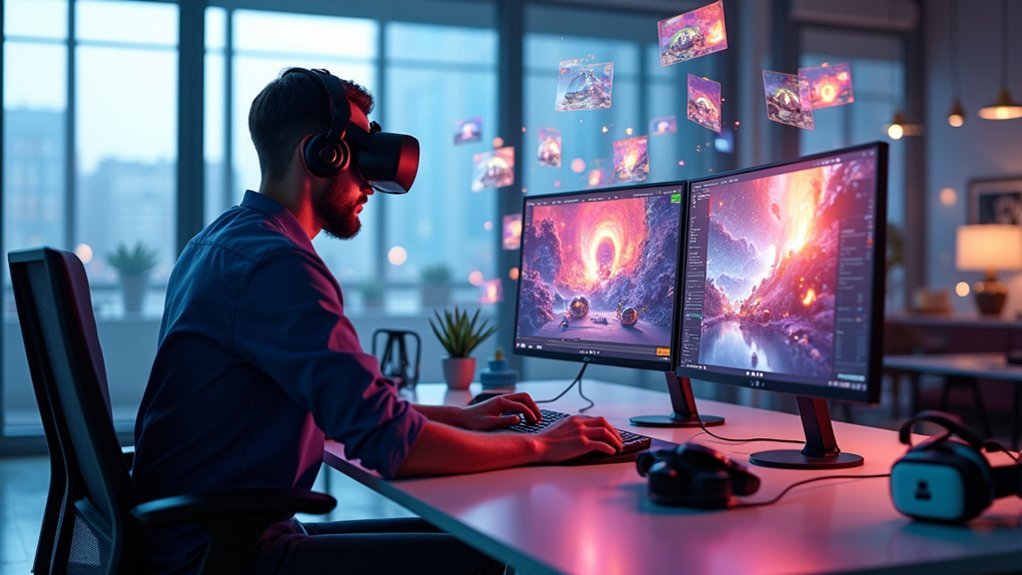


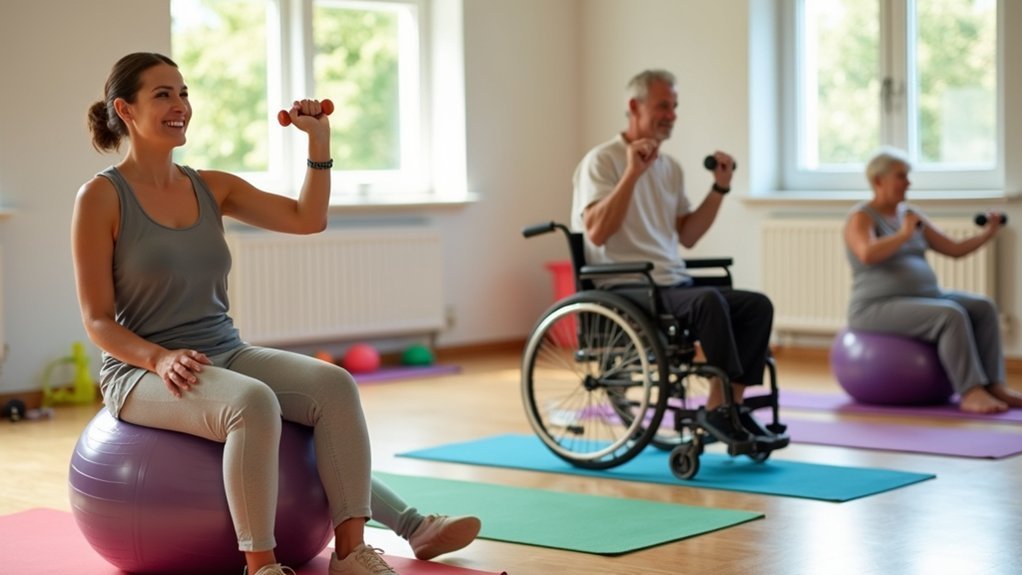
Leave a Reply